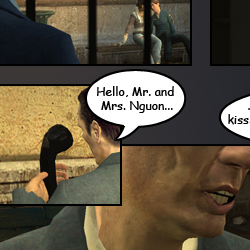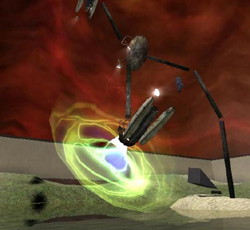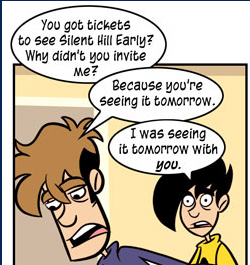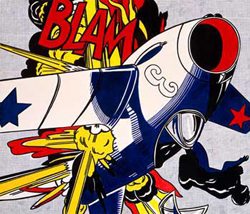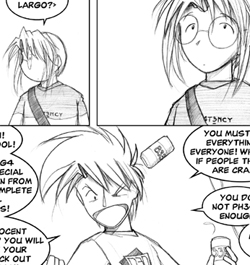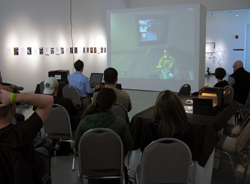David Hohusen
From Collectivate Course Wikis
Research
Abstract: Print-based comics are dying out in the United States. At the same time, webcomics are thriving. They are succeeding commercially in particular through sales of merchandise and ads. Stellar example are Megatokyo, PenniArcade, SinFest and others. The field of games has been exploding as a subculture and industry.
My project, MMO Times, brings games and comics together. Massively Multiplayer Online Times (MMO Times) combines the familiar aesthetics of games with daily news affairs. The concept of the piece is to inspire discussion about politics among gamers. MMO Times is a dynamic web portal for alternative news media. The project responds to latest international news events by using the popular aesthetics of games to attract youth to politics.
Already today, games are educational tools. At the recent "Games for Education" conference I learned that games foster mental development because gamers are required to learn complex systems quickly in order to enjoy gameplay. Gamers take in factual information (Age of Empires 3, Civilizaton IV). They learn goal-oriented social group interaction (World of Warcraft, Second Life, The Sims2), and they enhance hand-eye-reflex-coordination (Prince of Persia3, Smash Brothers).
However, currently there is no such game as the one proposed. As popular titles have shown (World of Warcraft over 4 million active subscribers) have shown, games have massive audiences. My argument is that youth gamers are not very engaged with the news. My project aims to correct that.
Week 1: Understanding Comics
"com-ics (kom'iks)n. plural in form, used with a single verb. 1. Juxtaposed pictoral and other images in a deliberate sequence, intended to convey information and/or to produce an aesthetic response in the viewer."
-Scott McCloud (1994) Understanding Comics. New York, p9.
Response:
McCloud gives a precise description of comics that is slightly wordy. For a more succinct description Will Eisner (whom Scott McCloud ref in his own book) defines comics as: "Sequential Art." This fundamental understanding of the medium I'm tapping into is significant in order to make progress.
Week 2: Gary's Mod
http://www.garrysmod.org/screenshots/view/collection/1673/
Response:
Garry's Mod, also known as GMod, is a game mod that is one the key elements in MMO Times' gamic production. Simply put, without Garry's Mod it would have been impossible to create the majority of current MMO Times' gamics.
A mod, aka modification, is a video gaming term that represents a genre of gaming as well as a style of production. A mod is a game that is created based on an original game or an existing game architecture (for instance game engines) that is developed by someone other than the original game designers. Mods can be entirely different kinds of games. Since mods are built from existing technologies the production labor in mods are considerably less in comparison to starting from scratch. Therefore, mods are often created by the general public. This independent development of games has created some of the more intriguing styles of gameplay. The alternative sandbox style of gameplay found in Garry's Mod serves as an excellent example.
In regards to gamic production, Garry's Mod serves as a tool for posing existing characters in a variety of environments from the Half-Life 2. Half-Life 2 is a first person shooter well reputed for its Havok physics engine. Basically, all the objects that exist within the Half-Life 2 environment have certain physical characteristics that emulate the physics found in reality. GMod is able to play with these simulations in a variety of ways. Most notably, the ability to suspend objects in time and space. The GMod physics gun is able to move objects and then freeze its position. This tool is able to manipulate the characters of Half-Life 2 (and any other custom characters models) in the same manner. The user simply is able to pick up the game character and pose them in a variety of positions and freeze them into place. Otherwise all of the characters are bound the physics of the game world, where they would flop around like rag dolls.
Although the majority of GMod users (including myself) are interested solely in gamic production, there are a slew of other intriguing features that exist. The available physics manipulation allow players to create elaborate Rube Goldberg devices. GMod features vast code manipulation via LUA Scripting that enables users to create there own mods from within GMod. Machinima, video created from game footage, is only taking the images found in gamics and multiplying over time. Essentially, GMod is very much like the sandbox architecture it tries to emulate. Its non-linear, and the user is simply allowed to do what he or she pleases to do.
Week 3: Questionable Content
Reading:
http://www.questionablecontent.net/
Week 4: Quantz
Reading:
Instructor's comment:
The first full-length machinima film was just released.
Perhaps also relevant is this blog by Jim Munroe. You will find many comic references there.
Week 5: Penny Arcade
Response:
Penny Arcade is one of the most successful and oldest webcomic that is still in production. Written written by Jerry Holkinsand illustrated by Mike Krahulik, Penny Arcade primarily focuses on the creator's alter egos (Tycho and Gabe) and their video game related misadventures. The comic's attitude is comical in nature and tends to prod various games in a jovial manner.
One interesting connection between Penny Arcade and MMO Times is although both comics are tied to video games, they're incorporated differently. MMO Times creates its imagery using video games and creates its content based on real current events. On the other hand, Penny Arcade creates imagery found in traditional comics (a simplification of reality) and creates its content based on the virtual worlds of video games.
Another note I'd like to make is the manner in which Penny Arcade posts its comics and its news. On PA's homepage, the first content the user encounters are news items. The initial news item (posted typically by Tycho) is related in some regards to the latest comic. As the user reads the news item, a link made to the comic. This fashion of updating users with both comics and information is appropriate because it allows the user to understand the context of the comic before seeing the comic. This approach helps prevent readers from missing the punch line of the jokes and makes sure the reader is on the same page as the writer. In the original incarnation of MMO Times, I took a similar approach to my gamics. After some feedback, I decided to adopt a new order for MMO Times (comic, followed by news, followed by user comments). I like this approach for MMO Times better because it allows the reader to discover the context of the comic on the their own terms before being subjected to the writer's or original article's point of view
Week 6: Roy Lichtenstein
ROY LICHTENSTEIN
Week 7: Comic Resources
Reading:
http://www.comicbookresources.com/
Week 8: Real Life Comics
Reading:
http://www.reallifecomics.com/
Week 9: Understanding Comics
"Think of your face as a mask. That’s what it is, after all. A mask. Facing outward. Worn from the day you were born. Slave to your every mental command. Seen by everyone you meet. But never by you. Open its eyes now. Just think it. The mask will obey. All set? Good. Now, SMILE.... C’mon nobody’s looking.... Good. Now, what changed when you smiled? What did you see? Nothing, right. Yet, you KNOW you smiled! Not just because you felt your cheeks compress or the crinkling around your eyes! You KNOW you smiled because you trusted this mask called your face to RESPOND! But the face you see in your mind is not the same as others see."
"When two people interact, they usually look directly at one another, seeing their partner’s features in vivid detail. Each one ALSO sustains a constant awarebess of his or her OWN face, but THIS mind-picture is not nearly so vivid; just a sketchy arrangement... a sense of shape... a sense of general placement. Something as simple and as basic as a cartoon."
-Scott McCloud (1994) Understanding Comics. New York, p35 - p36.
Response:
McCloud essentially proposes how cartoons are somewhat of a mental picture of a person's self image. This statement explains how cartoons are powerfully believable creatures. By taking an anonymous shape that could easily represent millions of different people cartoons are characters that the audience becomes while watching. Thus an instant sense of connection occurs and a relationship is formed. This argument of the "empty shell" of cartoons that allow viewers to become them has a makes some curious statements about cartoons. Basically it matters less who the cartoon is, and it's more imprortant what a cartoon has to say.
Prior to this discussion of a sense of self image he states how almost any shape easily becomes a face by adding a simple circle as an eye.
Week 10: Strip Generator
http://www.stripgenerator.com/
Week 11: MegaTokyo
Responce:
MegaTokyo is a manga styled web comic that focuses on the two protagonist's (Piro and Largo) adventures in a fictional Japan while searching for a way home to the United States. The comic is now created almost entirely by Fred Gallagher, who made MegaTokyo his primary source of income after losing his architecture job due to his company's downsizing. The main characters represent the main creator Fred Gallagher (Piro) and original writer Rodney Caston (Largo). Piro is a shy nerd obsessed with all things from Japanese pop-culture. Large is a delusional gamer that has a hard time separating reality from his game worlds. It is interesting to note that the character Largo is an over exaggerated version of MMO Times' target audience.
Week 12: Rules of Play I
In videogames two forms of emergence exist; emergent systems and emergent gameplay. Although both forms have a lot of similarities, the defining factor is where the emergence takes place. “The beginnings of emergence (in emergent systems), a higher-level pattern arising out of parallel complex interactions between local agents.”1 Simply put, if the emergence takes place inside of the game due to a series of unrelated low-level conditions to bring about a complex system of play, it is an emergent system. On the other hand, if the user interacts with a game in an unintentional or unexpected manner, it is an emergent gameplay. Both of these somewhat elusive forms of emergence have the capability to make or break a videogame, literally shaping the lives of people who interact with them.
With a focus of game design, videogames are rarely approached with a theoretical framework or critical vocabulary. This lack of precise evaluation is directly related to most videogames are developed with sales strategies rather than designed in search of meaningful play. The book entitled Rules of Play, written by a pair of game designers Katie Salen and Eric Zimmerman, is primarily interested in game studies to enhance the structure of game design. They write in their chapter dedicated to emergence, “Systems that are emergent systems generate unpredictable patterns of complexity from a limited set of rules. In an emergent system, the whole is greater than the sum of the parts. For example, limited set of the rules of grammar cannot account for all of the possible statements that might be made in a language.” Essentially gameplay gains value by having increased complexity for it gives gamers more content to explore and typically a more immersive experience.
1 Steven Johnson, Emergence
Week 13: Rules of Play II
Although emergent systems can be somewhat foreseen, designing a specific emergent structure is an arduous task and isn’t usually worth the effort. It has been my experience that by carefully designing the sum of the parts that have the potential to create a complex system of emergence can have surprising results. I personally engaged an interesting emergent situation while designing one of my first game projects that involved an artificial intelligent simulation of some creatures I created. The creatures, called jumpies, lived on a small island chain and their survival was dependent on their ability of traverse from one isle to the next by jumping the waterways. Amidst my development I kept a close eye on the jumpies and their Artificial Intelligence. I was determined to create a society that would be able to survive entirely on its own, with out user intervention. During this time I came across a very interesting emergent behavior, one I never planned for. The jumpies always spent more time on the larger central island than all of the smaller ones combined. The reason for this was simple; by being the largest island it had the largest amount of food and space to spread out. Jumpies of course loved food and disliked being too close to one another. Therefore, the large island suited the conditions of some smaller elements I had carefully designed. I could have easily changed the jumpies’ migration by taking away the food or by simply making the island smaller. But I decided to leave the game the way it was because it made sense and the jumpies also interacted with one another in a more dynamic fashion. This migration increased the complexity of my game and made my simulated experience more meaningful.
Week 14: Rules of Play III
Although game designers have strategized and recently philosophized about the impact emergent structures have on their videogames, emergent gameplay has proven itself just as crucial a game element. “Emergent gameplay is the creative use of a game in ways unexpected by the game designer's original intent. It commonly appears as complex behavior that emerges from the interaction of simple game mechanics. This is most common in computer games and is often prized by game designers. Emergent play can either be totally outside the game or have a direct impact on the gameplay.”2 Machinima is an example of emergent play that exists outside of a game. This notion can be somewhat confusing as machinima/gamics use games in their creation. However, they have no effect on the game or its virtual world and machinima/gamics aren’t typically viewed within a game environment.
A form of emergent play that has a direct impact on actual game play is currency trading/Chinese farming. Currency trading is when people pay real currency, typically on EBay, for virtual currency or virtual characters/items. This interesting notion of selling one’s virtual identity becomes particularly morbid due to the fact that virtual characters are often referred to as avatars (The mortal incarnation of a deity). Thus, selling one’s avatar is like selling ones religion to the highest bidder. The other term I mention earlier, Chinese farming, is actually far more sinister as it actually involves real people working in “sweatshops” for approximately 56 cents an hour.3 The term is racially coined due to most of the sweatshops exist in China. By using the prior method of currency trading, people actually stand to make a somewhat of a large profit of selling virtual items for real money. The only problem is, in order to actually make a decent amount of profit one would have to play multiple games simultaneously. Since it isn’t really possible for a single individual to play hundreds of games simultaneously, sweatshops of game stations exist to farming virtual items for large profit to the owner. “Last year alone, this newfound industry grossed roughly $500 million, according to Bob Kiblinger of UOTreasures.” 3 It has now become a responsibility for game designers to prevent such farming events from happening. Banning of IP addresses of users engaging such activities is the current strategy. However, while some forms of emergent play need to be subverted, are similar precautions required in regards to machinima?
2 Wikipedia: Emergent gameplay
3 1up.com: Wage Slaves
Week 15: Rules of Play IV
One of the major trends in emergent gameplay, which is seemingly ever growing in popularity, is the art of Machinima. “Machinima (a portmanteau word for machine cinema and/or machine animation) is both a collection of associated production techniques and a film genre.”4 The production technique/process is in regards to filming motion picture footage in a virtual gaming environment in attempts to use the game’s in-engine render to create an animation. The film genre refers to any film made in such a manner. Gamics, a cousin of machinima, creates comics in a similar fashion. Although typically looked down upon as a low level attempt at 3d animation, machinima titles “like ‘Hardly Workin’ and ‘Red vs Blue’ have already won awards at film festivals across the world. Machinima has been shown on television. And several Machinima films have clocked up well over a million viewers.”5
A common misconception is creating machinima/gamics are non-time consuming, un-skill intensive, and simple. Typically to prepare for a machinima or gamic project with such an attitude is a “recipe for total disaster.”6 Although creating a machinima/gamic certainly has its perks, no modeling, less expensive software, and real time rendering, it still is a full time production with plenty of challenges. Some of the major responsibilities of the production include scriptwriting, voice acting, storyboarding, acting/animating/posing, and post production. In many ways, especially considering comic creation, machinima/gamic creation is just as arduous as creating their ancestors. It is interesting to note, In-game or in-engine cutscenes are often considered to be poor quality in terms of cinematic enjoyment in comparison to conventional pre-rendered 3d animation. However, the opposite is true for the machinima creator. The realm of machinima frowns upon using motion image captures from any kind of cutscene for there isn’t any creative freedom or direction. Despite their sucesses, gamics and machinima artists are considered to be no more than simple hobbyist. However, as in-game renders become more and more similar to pre-rendered 3d images will machinima one day reach major box offices or gamics reach comic stands?
Throughout my discussion a few pointed have been raised about quality and responsibility. Do game designers have a responsibility to stop malicious forms of emergent gameplay? Yes, game designers, just like many others in the design field have a certain moral standard to uphold. Whether actions take place after problematic gameplay or games are designed to hinder such actions from taking place, it should be an element in the design workflow that cannot be overlooked. Another issue is should machinima be considered as a problematic behavior of gamers that needs to be subverted? Based on the current machinima scene there is no reason to hinder this creative process. Machinima is simply a way of enhancing gameplay through an emergent behavior on the part of the gamer. This emergent gameplay gives gamers a whole new approach to playing videogames that has the ability to help mold the video game medium as a whole. However, there is a breaking point. The breaking point is when machinima creators fail to meet their responsibility. Basically, with the ability to create entertainment brings with it a great responsibility. And if machinima creators fail such duties and cross the moral threshold that all designers are expected to maintain, game designers should take appropriate action to subvert that immoral instance. It is undeniable the influence of entertainment. For it is the actions of entertainers that hold the power to mold the future of those entertained.
4 Wikipedia: Machinima
5 Machinima.com: Welcome to the Revolution
6 Hugh Hancock, Gamasutra: Machinima Cutscene Creation, Part One
Project Development
Blogware Upgrade
The first version of MMO Times website was simple and offered the public concise access to news gamics. After launch there was an immediate outcry from subscribers for some form of user input. Personally not knowing any server-side languages a content management system (CMS) seemed to be a logical approach. I investigated three packages; WordPress, Mambo, and Textpattern.
Having some minor experience with blogware I started with a familiar package, WordPress. Perhaps the cleanest of the blog packages I’ve come across, WordPress is my personal blog’s software. It’s easy to manipulate, intuitive, user friendly, and easily redesigned. The package is perfect MMO Times except it seemed to be limited to being just-a-blog. I ultimately wanted my users to have more freedom and room for expansion. Thus, I looked into a very robust CMS called Mambo.
Mambo’s slogan is “power in simplicity.” Any user should be able to see a demonstration of Mambo’s power a few minutes past installation. The CMS has a plethora of built-in features and a friendly online community able to provide any other desired components. However, the robust and flexible package feels more like its own quirky operating system rather than a “simple” software package.
In the end I picked Mambo to support MMO Times content and so far I’m pleased with its performance. All of the features it provides are extremely useful and I’ve finally have a grip on its complex user interface.
WordPress
"WordPress is a blog publishing system written in PHP and backed by a MySQL database. It is distributed under the GNU General Public License and is available free of charge. It has been downloaded hundreds of thousands of times to date. The latest version is 2.0.2."
Mambo
“Mambo (formerly named Mambo Open Source or MOS) is an open source content management system (CMS) for creating and managing websites through a simple web interface. It has attracted many users due to its ease of use. Mambo also includes more advanced features such as page caching to improve performance on busy sites, advanced templating techniques, and a fairly robust API. It can also automate many tasks such as web indexing for static pages. Mambo can provide RSS feeds, printable versions of pages, news flashes, blogs, forums, polls, calendars, website searching, language internationalization, and other possibilities.”
Textpattern
"Textpattern is an open source content management system originally developed by Dean Allen. While it is often listed among weblogging tools, its aim is to be a high-quality general-purpose CMS suitable for deployment in many contexts. Textpattern is written in PHP using a MySQL database backend, and is distributed under the GNU General Public License. The current stable version is Textpattern 4.0.3."
Gamic Development
Who Should Make Gamics?
A common misconception is creating gamics are non-time consuming, un-skill intensive, and simple. Entering the field of gamics with such an attitude will most likely lead to failure. For those who do not LOVE video games or comics I strongly suggest avoiding gamic production. After a year of gamic production experience and a life time of gaming/comic reading, it takes me approximately three hours to create a single gamic.
So who should make gamics? For starters, YOU! By reading this documentation of MMO Times gamic production you’re obviously have enough interest and motivation to being your very own gamic series. So encourage you to continue your research by reading the rest of the documentation and I hope it starts you off on the right path of you gamic adventures.
However, comic and gaming enthusiast alike, making gamics can be an extremely rewarding and enjoyable practice.
Choosing A Game
Perhaps the single most important choice in the gamic production process is what game to use. Video games have been in production for a number of years that a gamic producer has the ability to find any desired aesthetic for their gamic. However, games aren’t typically designed for gamic creation. There are tons of limitations placed on users within gaming environments, typically all elements of gameplay. Simply put most games don’t allow users to play as gods to pose in-game objects and change the settings of the game environment.
A good example of a game that people use to create gamics and machinima a like is World of Warcraft (WoW). WoW, as well as most Massively Multiplayer Online Games (MMOG), only allow players to assume the role of a single character within a vast virtual world. Thus, to create a simple dialog between two characters would require at least three players to create (actor one, actor two, and the cameraman). Therefore, people interested in creating a solo gamic production would be unable to do so in such a gaming platform. The upside to using a MMOG is that the characters are versatile actors and there are vast amounts of environments to use (if your able to fight your way to them).
Games I recommend for gamic production are:
Half-Life 2
The Sims 2
Halo / Halo 2
The Movies
Second Life
World of Warcraft
Half-Life 2 and Garry’s Mod
All of the MMO Times' gamics are created using Valves Half-Life 2 with the aid of Garry’s Mod (GMod). Half-Life 2 is a science fiction first-person shooter that takes place in a post apocalyptic world controlled by aliens. The game’s hallmark is its Havok physics engine that simulates real world physics of all the objects in the game. The open-ended GMod is a sandbox game with the ability to manipulate the game world of Half-Life 2. Together, I’ve yet to find a more suitable gamic production tool.
Post Production
Like all of aspects of gamic production, gamic post production has its similarities and differences from traditional comic post production. For example, gamic designers should have a more extensive collection of image resources. However, just like photography gamic screen shots capture all of the game elements the screen from that moment of game time. Thus, some desired elements may be out of frame and undesired elements may be in frame. In comparison to traditional comics, gamics have a less eloquent approach to creating its imagery. Like a good photographer, a solution to this issue is to take as many “pictures” as possible. There is not thing as over shooting a frame.
Layouts between comics and gamics are essentially identical. Gamics and comics designers alike want their reader to view a page left to right and then top to bottom. It’s important that not only the frames, but the text and character suggest this movement as well.
The web medium is certainly another element to consider while creating gamics. For example, web pages have the ability to scroll infinitely vertical. Thus frames and layouts can be much taller than print. Another factor is web resolution verse print resolution. Print is over three times more detailed than the web. Therefore, images will appear more crisp and text easier to read.
